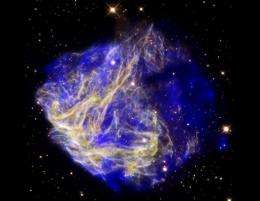This NASA composite image obtained in June 2010 shows N49, the aftermath of a supernova explosion in the Large Magellanic Cloud. An Australian company has developed a laser tracking system that will stop chunks of space debris colliding with spacecraft and satellites in the Earth's orbit.
An Australian company Tuesday said it had developed a laser tracking system that will stop chunks of space debris colliding with spacecraft and satellites in the Earth's orbit.
Electric Optic Systems said lasers fired from the ground would locate and track debris as small as 10 centimetres (four inches) across, protecting astronauts and satellites.
"We can track them to very high precision so that we can predict whether there are going to be collisions with other objects or not," Craig Smith, the company's CEO, told AFP.
Smith said the technology improved upon existing radar systems because it could detect tiny objects, left behind by disused rockets and satellites, which can still devastate hardware because they are travelling at ultra-high speeds.
He said there were an estimated 200,000 objects measuring less than one centimetre floating in orbit, with another 500,000 of a centimetre or larger.
"It ranges from bus-size bits of rocket bodies all the way down to a little half-a-millimetre fleck of paint," Smith said from the company's headquarters in Canberra.
"The trouble is that they're all travelling at about 30,000 kilometres (19,000 miles) an hour. So unless you're in the same orbit you have hyper-velocity impacts, which can be devastating to a satellite."
Electric Optic Systems said it had developed the technology thanks to a four million dollar (3.5 million US) grant from the Australian government.
Smith said the company has received interest in the lasers, developed at Canberra's Mount Stromlo Observatory, from around the world.
But he said the system would work best with a network of tracking stations placed at strategic points around the globe.
"A network is better than a single station of your own because -- particularly in lower earth orbit -- things are not always coming over your head when you want them to be," said Smith.
(c) 2010 AFP























